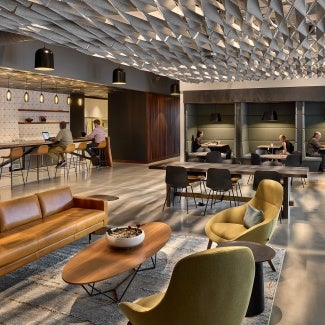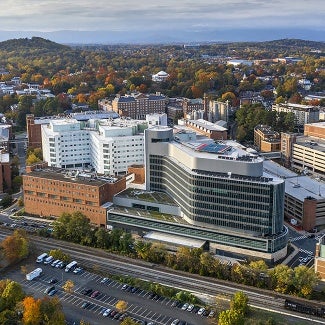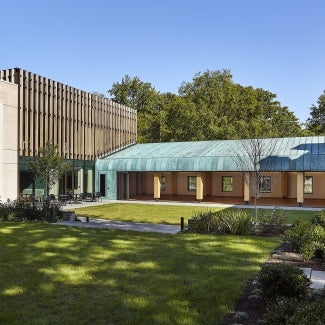Martin Luther King Jr. Memorial Library
The award-winning interior architecture of the Martin Luther King Jr. Memorial Library transforms an aging cultural complex into a socially sustainable engine for knowledge exchange.

Project highlights: Martin Luther King Jr. Memorial Library
- Architect: OTJ Architects and Mecanoo
- Owner: DC Public Library
- Location: Washington, DC
This project is the focal point of the Washington, DC Public Library's ambitious initiative to renew its aging infrastructure and reposition its libraries as vital resources in the digital information age. The Martin Luther King Jr. Memorial Library, which opened in 1972, is Ludwig Mies van der Rohe's only building in the district and his only realized library in the world. In addition to greatly enhancing library services and reorganizing its program, the team also created a test case for sensitively transforming an aging cultural complex into a socially sustainable engine for knowledge exchange.
Beginning in the early 2000s, the library suffered greatly from continued disinvestment and a spate of exciting new library designs for other major American cities. In light of the digital age, the library stood as a grim relic of the past, leading many major voices in D.C. to call for its closure and relocation. The efforts of historic preservationists were victorious, however, and the building received landmark status in 2007, ending all conversations supporting its demolition.
From the project's onset, the team delved deeply into the stakeholder engagement that steered the design's direction. In addition to a rigorous entitlements process with the city and federal agencies, extensive research was conducted through dialogues with architect Jack Bowman, who worked on the original building, and Charles Cassell, who successfully championed the initiative to name the library after Dr. King.
In overcoming significant challenges, namely about 50 years of deferred maintenance and a failing exterior envelope, the reborn library highlights its role as a place for social gathering and its presence as a community landmark. The new design respects the potent simplicity of Mies' original building and carefully balances the legacies of the legendary architect and civil rights leader. To that end, the team employed a contrasting design idiom, a wood-slatted, curvilinear finish, and form that humanizes the glass and steel signature of Mies' work. It applies to the interior and exterior elements, service bays, and monumental stairs to work harmoniously with and complement the original library's form and discipline.
The library now offers nearly 100,000 square feet of public space, which is carefully programmed to provide residents with new opportunities to learn and connect. As patrons move through the skylit stairs, different experiences on each floor greet them. The team also removed long corridors and the existing oppressive buff yellow brick walls on the upper floors to shape new collaborative experiences, including cowering space, a community services zone, an interactive exhibition space, and a 300-seat auditorium.
The library system anticipates welcoming nearly one million visitors in the post-COVID environment. In offering spaces and services to district residents of all ages and from all walks of life, the library is a crucial civic anchor for downtown businesses as they recover from the pandemic.
Project team & Jury
Engineers
MEP/Fire Protection: Collaborative Engineering Group
Plumbing / Fire Protection Engineer - Under CEG: Engenium
Structural Engineer: Silman
Civil Engineer: Wiles Mensch Corp
Consultants
Land Surveyor: Wiles Mensch Corp
Landscape: Oehme van Sweden
Acoustical, Audio/Visual, IT Infrastructure, & Security Consultant: Jaffe Holden
Security Consultant: D'Agostino & Associates, under Jaffe Holden
Historic Preservation Consultant: EHT Traceries
Envelope Consulting and Preservation: Wiss, Janney, Elstner Associates
Environmental Planning Consultant: Stantec
Traffic Engineer: Stantec
Code Consultant: Jensen Hughes
LEED Consultant: Greenshape, LLC
Specification Writer: Heller & Metzger, PC
Lighting Consultant: George Sexton Associates
Vertical Transportation: Lerch Bates
Wayfinding: Design Army
Geotechnical Engineer: Schnable Engineering
General contractor: Smoot / Gilbane III MLK, A Joint Venture; CMAR: Jair Lynch Real Estate Partners
Rudabeh Pakravan, AIA, Chair, Sidell Pakravan, Berkeley, Calif
Rebecca Brady, AIA, Clark Nexsen, Virginia Beach, Va.
Joyce Selina Love, AIA, DesignLoveStudio, Memphis, Tenn.
Alejandra Menchaca, Thornton Tomasetti, Boston
Melanie Ray, AIA, Hord Coplan Macht, Inc., Baltimore
The Interior Architecture program celebrates the most innovative and spectacular interior spaces. Impactful building interiors make their mark on the cities, places, and spaces where we live and work.
Explore eight projects showcasing the best in interior architecture and design.













